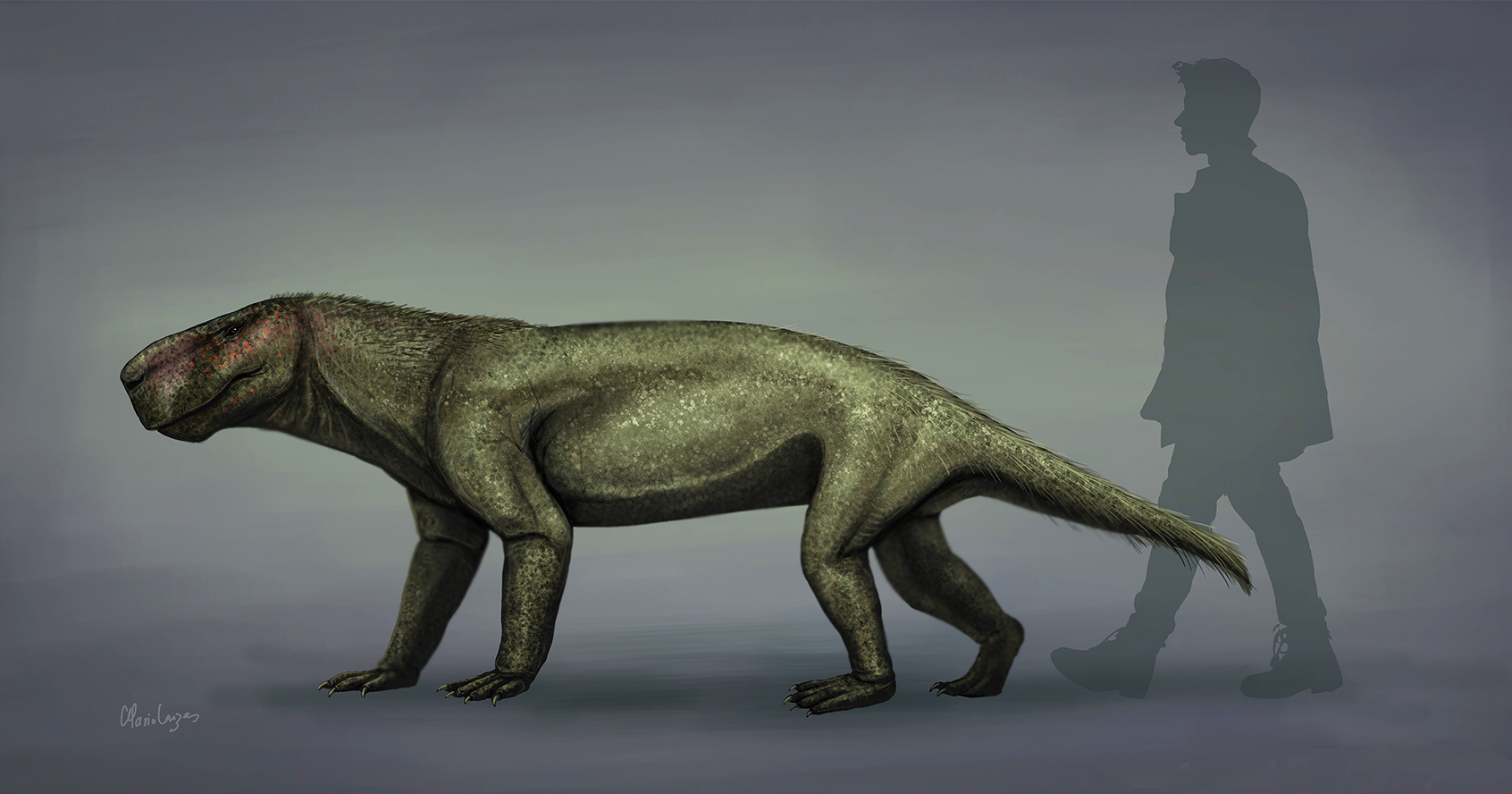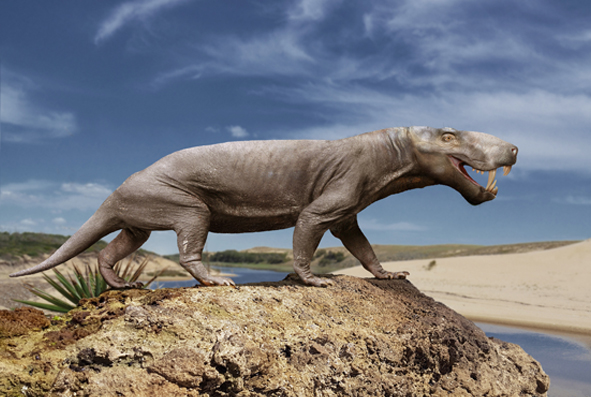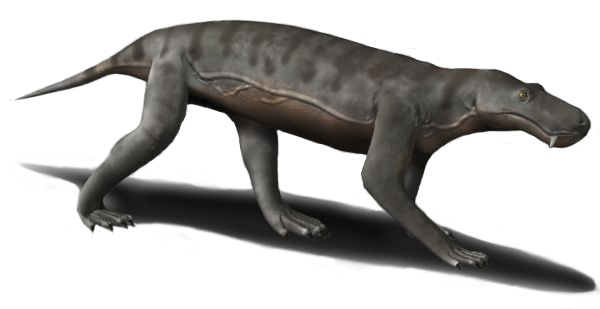|
Gorgonopsia
Gorgonopsia (from the Greek Gorgon, a mythological beast, and 'aspect') is an extinct clade of sabre-toothed therapsids from the Middle to Upper Permian roughly 265 to 252 million years ago. They are characterised by a long and narrow skull, as well as elongated upper and sometimes lower canine teeth and incisors which were likely used as slashing and stabbing weapons. Postcanine teeth are generally reduced or absent. For hunting large prey, they possibly used a bite-and-retreat tactic, ambushing and taking a debilitating bite out of the target, and following it at a safe distance before its injuries exhausted it, whereupon the gorgonopsian would grapple the animal and deliver a killing bite. They would have had an exorbitant gape, possibly in excess of 90°, without having to unhinge the jaw. They markedly increased in size as time went on, growing from small skull lengths of in the Middle Permian to bear-like proportions of up to in the Upper Permian. The latest gorgonops ... [...More Info...] [...Related Items...] OR: [Wikipedia] [Google] [Baidu] |
Scylacops
''Scylacops'' (meaning "face that tears") is an extinct genus of Gorgonopsia. It was first named by Broom in 1913,Broom, R. "On the Gorgonopsia, a Sub-order of the Mammal-like Reptiles." ''Proceedings of the general meetings for scientific business of the Zoological Society of London''. (1913): 225-230. and contains two species, ''S. bigendens'', and ''S. capensis''. Its fossils have been found in South Africa and Zambia. It is believed to be closely related to the Gorgonopsian '' Sauroctonus progressus''. ''Scylacops'' was a moderately sized Gorgonopsid. Scylacops is an carnivorous therapsid, existing from 259.0 to 254.0 Ma. ''S. bigendens'' was first described by Brink and James Kitching in 1953, although its original description was ''Sycocephalus bigendens''.Brink, A. S., and J. W. Kitching. "Studies on new specimens of the Gorgonopsia." ''Palaeontologia africana'' 1 (1953): 1-28. According to the paleobiology database ''Scylacops'' specimens have been found in the following l ... [...More Info...] [...Related Items...] OR: [Wikipedia] [Google] [Baidu] |
Viatkogorgon
''Viatkogorgon'' is a genus of gorgonopsian (a type of therapsid, the group that includes modern mammals) that lived during the Permian period in what is now Russia. The first fossil was found at the Kotelnich locality near the Vyatka River and was made the holotype of the new genus and species ''V. ivachnenkoi'' in 1999. The generic name refers to the river and the related genus '' Gorgonops''—the gorgons of Greek mythology are often referenced in the names of the group. The specific name honors the paleontologist Mikhail F. Ivakhnenko. The holotype skeleton is one of the most complete gorgonopsian specimens known and includes rarely preserved elements such as gastralia (abdominal ribs) and a sclerotic ring (a bony ring inside the eye). A larger, but poorly preserved specimen has also been assigned to the species. The holotype specimen is about long, including the long skull, making ''Viatkogorgon'' a relatively small gorgonopsian. The assigned specimen is larger, with ... [...More Info...] [...Related Items...] OR: [Wikipedia] [Google] [Baidu] |
Phorcys Dubei
''Phorcys'' is an extinct genus of gorgonopsian (predatory therapsids, related to modern mammals) that lived during the Middle Permian period (Guadalupian) of what is now South Africa. It is known from two specimens, both portions from the back of the skull, that were described and named in 2022 as a new genus and species ''P. dubei'' by Christian Kammerer and Bruce Rubidge. The generic name is from Phorcys of Greek mythology, the father of the Gorgons from which the gorgonopsians are named after, and refers to its status as one of the oldest representatives of the group in the fossil record. ''Phorcys'' was recovered from the lowest strata of the ''Tapinocephalus'' Assemblage Zone (AZ) of the Beaufort Group, making it one of the oldest known gorgonopsians in the fossil record—second only to fragmentary remains of an indeterminate gorgonopsian from the older underlying ''Eodicynodon'' Assemblage Zone. ''Phorcys'' was also unexpectedly large for an early gorgonopsian with ... [...More Info...] [...Related Items...] OR: [Wikipedia] [Google] [Baidu] |
"Dixeya" Nasuta
"''Dixeya''" ''nasuta'' is a species of the predatory gorgonopsian therapsids from the Late Permian of East Africa, known from fossils found in what is now Tanzania. The species has a complicated taxonomic history, it was originally named as a second species of the genus ''Dixeya'' which is now considered a junior synonym of '' Aelurognathus''. "''D.''" ''nasuta'' itself, however, was not moved to ''Aelurognathus'', and although it was instead tentatively referred to '' Arctognathus'' at first it has since been recognised to not belong to this genus either. This situation leaves "''Dixeya''" ''nasuta'' without a formal genus name. It was proposed to belong to a new distinct genus, named "Njalila", that was informally proposed for the species in a PhD thesis, but this name has not yet been formally published and is currently a ''nomen nudum''. "''D.''" ''nasuta'' has been characterised from other gorgonopsians by a combination of its straight snout profile, upturned and 'pinched' ... [...More Info...] [...Related Items...] OR: [Wikipedia] [Google] [Baidu] |
Eriphostoma
''Eriphostoma'' is an extinct genus of gorgonopsian therapsids known from the Middle Permian (middle Capitanian stage) of ''Tapinocephalus'' Assemblage Zone, South Africa. It has one known species, ''Eriphostoma microdon'', and was first named by Robert Broom in 1911. It is the oldest known gorgonopsian and among the smallest and most basal members of the clade. Description Gorgonopsians were a morphologically conservative group, and like all gorgonopsians, ''Eriphostoma'' would have been a quadrupedal predator. It was among the smaller members of the group, with a skull less than long. It had a relatively short, deep snout and large orbits compared to other gorgonopsians. Like all gorgonopsians, it had five incisors and a canine tooth on each side of the upper jaw, but it had only three small postcanine teeth in its maxilla. The palate of ''Eriphostoma'' has delta-shaped palatine bosses covered in numerous teeth, like '' Gorgonops'' and many basal therapsids, but not more d ... [...More Info...] [...Related Items...] OR: [Wikipedia] [Google] [Baidu] |
Inostrancevia
''Inostrancevia'' is an extinct genus of carnivorous therapsids, containing the largest members of gorgonopsians, predators characterized by long, saber-tooth-like canines. The various species inhabited European Russia during the Upper Tatarian (Vyatskian), a Russian regional stage equivalent to the Wuchiapingian and Changhsingian stage of the Late Permian period, dating from approximately 259 to 252.3 million years ago. The genus name was described posthumously, after the Bolshevik Revolution, by the Russian paleontologist Vladimir P. Amalitsky in 1922, in honor of geologist Aleksandr Inostrantsev. The first fossils attributed to ''I. alexandri'' are found in Arkhangelsk Oblast, near the Northern Dvina at the end of the 19th century, making it the first gorgonopsian known from Russia, the only place outside Africa where they are officially recognized. Some fossils of the species in question are among the most complete remains of gorgonopsians ever identified to date, t ... [...More Info...] [...Related Items...] OR: [Wikipedia] [Google] [Baidu] |
Aelurognathus
''Aelurognathus'' is an extinct genus of gorgonopsian therapsids from the Permian of South Africa. Discovery The type species is ''Aelurognathus tigriceps'', originally named ''Scymnognathus tigriceps'' by South African paleontologists Robert Broom and Sydney H. Haughton in 1913, and later assigned to the new genus ''Aelurognathus'' by Haughton in 1924. ''Scymnognathus parringtoni'' von Huene, 1950, previously assigned to ''Aelurognathus'', is now classified as a species of '' Sauroctonus''. ''Aelurognathus nyasaensis'' Haughton, 1926 is not referable to the genus.Kammerer CF. (2016) Systematics of the Rubidgeinae (Therapsida: Gorgonopsia) PeerJ 4:e1608 https://doi.org/10.7717/peerj.1608 Palaeobiology A broken tooth beside the skeleton of a dicynodont from the ''Tropidostoma'' Assemblage Zone has been attributed to ''Aelurognathus'', indicating that it scavenged. The bones of the back of the skeleton are the most scattered, suggesting that the ''Aelurognathus'' individuals ... [...More Info...] [...Related Items...] OR: [Wikipedia] [Google] [Baidu] |
Gorgonops
''Gorgonops'' (from el, Γοργών 'Gorgon' and 'eye, face', literally 'Gorgon eye' or 'Gorgon face') is an extinct genus of gorgonopsian therapsids, of which it is the type genus, having lived during the Late Permian (Wuchiapingian), about 260–254 million years ago in what is now South Africa. Despite its popularity, ''Gorgonops'' is a medium-sized gorgonopsian (about long maximum), regularly confused by the general public with the more massive ''Inostrancevia'', known from Russia, due to their similar appearance and the various media that tend to refer them by the name of the group they belong rather than by their genus names, which does not help in differentiation. History of discovery The holotype of the type species, ''Gorgonops torvus'', was in 1876 one of the first therapsids described, by Richard Owen, who also coined the name "Dinosauria" on the basis of the first known dinosaur fossils. It was also used as the type for which Richard Lydekker described the famil ... [...More Info...] [...Related Items...] OR: [Wikipedia] [Google] [Baidu] |
Smilesaurus
''Smilesaurus'' is an extinct genus of gorgonopsian known from Africa. It lived during the Late Permian. It contains the single species ''S. ferox''. Description ''Smilesaurus'' was a large gorgonopsian, with a skull length of up to 31 centimeters. It is characterized by extremely long canine teeth, and has the proportionally longest canines of any gorgonopsian. Unlike other gorgonopsians, which probably hunted similarly to predatory reptiles, ''Smilesaurus'' probably was a true saber-toothed predator which hunted using similar tactics to saber-toothed cat Machairodontinae is an extinct subfamily of carnivoran mammals of the family Felidae (true cats). They were found in Asia, Africa, North America, South America, and Europe from the Miocene to the Pleistocene, living from about 16 million until ...s. It can be distinguished by other rubidgeines by its lack of cranial pachyostosis and rugosoties, and by its relatively small orbits. Classification The classification of ''S ... [...More Info...] [...Related Items...] OR: [Wikipedia] [Google] [Baidu] |
Lycaenops
''Lycaenops'' ("wolf-face") is a genus of carnivorous therapsids. It lived during the Middle Permian to the early Late Permian, about 260 mya, in what is now South Africa. Description ''Lycaenops'' measured about and weighed up to . Like the modern-day wolves from which it takes its name, ''Lycaenops'' had a long and slender skull, with a set of dog-like fangs set into both its upper and lower jaws. These pointed canine teeth were ideal for the use of stabbing and/or tearing at the flesh of any large prey that it came upon. ''Lycaenops'' most likely hunted small vertebrates such as reptiles and dicynodonts. ''Lycaenops'' walked and ran with its long legs held close to its body. This is a feature found in mammals, but not in more primitive amniotes, early reptiles, and synapsids such as pelycosaurs, whose legs are positioned to the sides of their bodies. The ability to move like a mammal would have given ''Lycaenops'' an advantage over other land vertebrates, since it would ha ... [...More Info...] [...Related Items...] OR: [Wikipedia] [Google] [Baidu] |
Arctognathus
''Arctognathus'' is an extinct genus of gorgonopsids that throve during the Late Permian in the Karoo basin of what is now South Africa. Discovery A carnivore, like all gorgonopsid, ''Arctognathus'' was given its name ("Bear jaw") in reference to its short and rounded snout. There is only one recognized species, ''A. curvimola''. Description It was a small gorgonopsid with a total length estimated at 1.1 m and an 18 cm skull. Classification Below is a cladogram from the phylogenetic analysis of Gebauer (2007): See also * List of therapsids This list of therapsids is an attempt to create a comprehensive listing of all genera that have ever been included in the Therapsida excluding mammals and purely vernacular terms. The list includes all commonly accepted genera, but also genera tha ... References Bibliography * * Gorgonopsia Prehistoric therapsid genera Lopingian synapsids of Africa Fossil taxa described in 1911 Taxa named by Robert Broom Lo ... [...More Info...] [...Related Items...] OR: [Wikipedia] [Google] [Baidu] |
Nochnitsa
''Nochnitsa'' (rus.: ночница, literally – nightling) is a genus of gorgonopsian therapsid from the Kotelnich red beds of Permian Russia. It contains one species, ''Nochnitsa geminidens''. It the most basal known gorgonopsian and among the smallest members of the clade known to date. Discovery and naming ''Nochnitsa'' is known from only one specimen, the holotype KPM 310. It was found in Vanyushonki Member of the Kotelnich red beds, along the Vyatka River in Kirov Oblast, which dates to the latest Guadalupian or early Lopingian epochs. ''Nochnitsa'' is named after the Nocnitsa, a nocturnal hag-like creature from Slavic mythology. Its name was intended as a parallel to the Gorgons, similarly hag-like creatures from Greek mythology, which are the namesake of many genera within Gorgonopsia and the clade as a whole. The name also reflects the nocturnal habits inferred for the genus. The type species name, ''N. geminidens'', means "twin tooth" and refers to one of the autapo ... [...More Info...] [...Related Items...] OR: [Wikipedia] [Google] [Baidu] |








.jpg)

